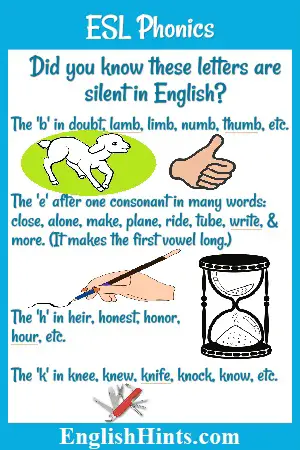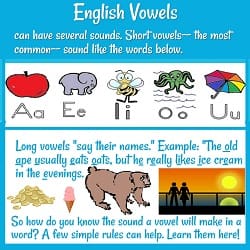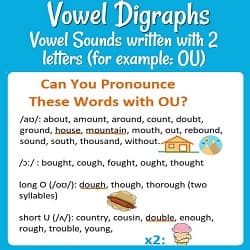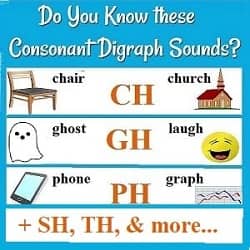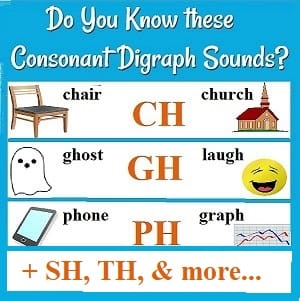ESL Phonics Tips
These ESL Phonics guidelines can improve your reading and spelling. They can help you recognize words and spelling patterns.
Phonics shows the relationships between the letters and sounds of a language. Most English phonics instruction is to help native English-speaking children learn to read. (They need help too, since letters do not always represent the same sounds in English.)
ESL Phonics instruction is a little different from the phonics that English-speaking children study.
Most people studying English as a second (or third or fourth) language are already literate.
They know the basic sounds of alphabet letters in English as well as their own language (if alphabetic.)
If that describes you, you may find that a little ESL phonics instruction can help a lot. You will be able to recognize more words you know, as well as to understand how to pronounce and spell new words.
Standard English has about 42 sounds (with some differences by dialect) but only 26 letters. Many letters can be pronounced in two or more ways. Most sounds can be represented by more than one letter. (Sorry about that!)
There are historical reasons why English spelling does not match its sounds:
- a major shift in vowel sounds after printing began to standardize spellings,
- no central language academy with authority to enforce consistent pronunciation or spelling, and
- heavy borrowing of words from other languages, often keeping part of their spelling.
(For more information, see English Word Origins.)
On this page I’ll try to give a brief explanation of the most common sounds of each letter of the alphabet. Note that most consonants have one main sound, with common exceptions noted afterwards.
I've included the International Phonetic Alphabet (IPA)) symbols for each sound before the example words.
Vowels-- A , E, I, O, & U-- have long, short, and ‘r’-controlled sounds, as well as the ‘schwa’ sound for unaccented syllables. Two vowels together are usually pronounced as one sound (a digraph). Most often it is the long sound of the first vowel, but it can be any sound of either vowel, or another sound.
(The 'ei' in 'neighbor' and 'weigh' is pronounced as a long A. The 'ei' in 'heights' has a long I sound. In 'deceive, receive, receipt,' etc. it has a long E sound, & in 'either' it can be either a long E or a long I, depending on dialect/area.)
For more information
on vowel sounds see Short
and Long English Vowels and English Vowel Digraphs. (Digraphs are sounds written with two letters.)
See also Consonant Digraph Sounds.
ESL Phonics: Common Sounds For Each Letter
A
Short A (/æ/): at, class, plan, sad
Long A (/eɪ/): ate, day, plane, say
The /ɑ/ sound of father or watch.
Plus the /ə/ (schwa) sound in unaccented syllables & digraph sounds when A is combined with another vowel.
B
/b/: bank, bed, boat, bubble, by, double, number, verb
Sometimes ‘b’ is silent, especially after ‘m’ or before ‘t’: comb, debt, doubt, dumb, lamb, numb, thumb.
C
C has a hard (‘k’) sound before ‘a,’ ‘o,’ & ’u,’ (or when followed by ‘k’ or other consonants), and a soft (‘s’) sound before ‘e’ or ‘i.’
/k/: cab, call, cat, coin, colony, cube, cut, lick, sack
/s/: cent, celery, certain, cipher, fascinate, lice, race.
/ʃ/ (Sh) crucial, social
For CH (/tʃ/) see Consonant Digraph Sounds (link just above the alphabet list.)
D
/d/: dad, dead, decided, said, tried
D makes a /t/ sound after certain (unvoiced) consonants: baked, hoped, fixed, guessed, washed.
E
Short E (/ɛ/): address, desk, exit, pen, red, seven
Long E (/iː/): complete, meaning, peel, sweet, three
Silent E (makes the preceding vowel long): close, cube, like, name, take.
Plus the /ə/ (schwa) sound in unaccented syllables & digraph sounds when E is combined with another vowel.
F
/f/: face, feel, fluffy, free, puff.
(For the F sound, see also GH & PH on the Consonant Digraph Sounds page. See the link above the alphabetical list.)
G
G makes a hard ‘G’ sound before A, O, & U, as well as before L & R and at the middle and end of words (/g/): drug, game, gave, glass, glitter, gold, got, grass, great, rag, seagull, segment.
It usually makes a soft ‘J’ sound before E or I (/dʒ/): generous, genetic (the same beginning sound as Jennifer), ginger, gist.
Exceptions include the hard G of get, girl, and give. (See also GH, Consonant Digraph Sounds.)
H
/h/: hair, half, help, hero, hit, home.
An initial ‘h’ is often silent, (depending on its derivation-- the language it came from): herb, honest, honor, hour.
See also CH, GH, PH, SH, TH, and WH in Consonant Digraph Sounds.
I
Short I (/ɪ/): in, pill, sick, six.
Long I (/aɪ/): five, nine, right, write.
Plus the /ə/ (schwa) sound in unaccented syllables & digraph sounds when I is combined with another vowel.
J
J is usually pronounced /dʒ/ in English: jam, John, juice, just, major.
For more J sounds see G.
K
/k/: back, bake, keep, kind, kiss, make, rack, truck.
At the beginning of words, we usually use K before E or I, and we use C for the /k/ sound before A, O, or U.
At the end of words, the K sound is often written CK (to keep the preceding vowel clearly ‘short.’)
For KN see Consonant Digraph Sounds.
L
/l/: all, lake, lack, light, lily, listen, love, silent, still.
L is silent in could, should, would, half (& calf), folk, talk & walk & in many dialects in calm & palm.
M
/m/: am, make, mine, moment, some.
N
/n/: any, man, name, nine, none, turn.
For the N sound see also KN in Consonant Digraph Sounds. (See also the NG digraph.)
O
Short O (/ɑ/): dog, drop, hot, mop, not, on, stop.
Long O (/oʊ/): : alone, boat, bone, cold, no, note, open, own, rose.
The /u:/ sound: do, lose, prove, who
The short U sound (/ʌ/): come, does, month, of
Plus the /ə/ (schwa) sound in unaccented syllables & digraph sounds when O is combined with another vowel.
P
/p/: apple, pay, pen, pie, place, pretty, top, wrap.
P is silent in some words of Greek origin: pseudonym, pneumonia, psychic or psychological, etc.
(See also PH in Consonant Digraph Sounds.)
Q
/kw/: quantity, queen, quit, quite.
(See QU in Consonant Digraph Sounds.)
R
/ɹ/: air, arm, baker, bird, charge, fur, hear, or, ran, red, rose, service, trial, turn.
S
/s/: backs, glass, laughs, maps, mats, pots, say, sell, sold.
S is pronounced 'Z' after a voiced consonant like B, D, G, L, M, N, R, or V or after vowels (all voiced)-- /z/: bills, comes, does, gives, plans, tabs, tags, use, was, words
See SH in Consonant Digraph Sounds.
T
/t/: at, met, pot, tall, test, taught.
/ʃ/ (SH): cautious, communication, description, initial, nation
See also TH in Consonant Digraph Sounds.
U
Long U (/ju/): cute, mute, use, value.
/u/: assume, rule, tune
Short U (/ʌ/): cup, rug, tub, under, up, us.
/ʊ/: full, push, pull, put, sugar
Plus the /ə/ (schwa) sound in unaccented syllables & digraph sounds when U is combined with another vowel.
(See QU in Consonant Digraph Sounds.)
V
/v/: give, leave, love, value, very, visit, voice.
W
/w/: want, water, week, wife, will, wood, word.
W is silent in many words beginning WR: wrap, wreck, write, wrong.
See WH in Consonant Digraph Sounds. (Also see the AW, EW, and OW digraphs in English vowels, in which the W takes the place of U: awful, saw, new, brown, cow, grow, show.)
X
/ks/: X usually makes the sound /ks/: box, excited, six, toxic.
Y
Y makes the International Phonetic Alphabet /j/ sound: year, yellow, yes, yet, you, young.
Y can also serve as a vowel, taking the place of I, either as /ɪ/ in the first 'y' in mystery,
or /aɪ/ : cry, dry, fly, my, sky, try, type, or why,
or /iː/, especially at the end of multi-syllable words: any, carry, city, easy, lonely, quickly, sorry, study or very.
It is also part of the AY and OY vowel digraphs in play, say, way, boy and destroy.
Z
/z/: buzz, fuzzy, zero, zoo.
(Many times S, especially in plurals, makes the /z/ sound: boys, news, noise-- or the first 's' in business, which sounds like 'biz-ness.')
________________________
I hope these ESL Phonics hints help you spell words you know and recognize and pronounce words you read. (Even native English speakers are often unsure how to pronounce a word they read but have not heard.)
That’s why English dictionaries begin a word’s entry with its pronunciation. (Sometimes the word will have more than one pronunciation!)
Don’t worry too much about getting it perfect. Keep listening and keep reading. More and more words will become familiar to you!
You Might Also Like:
Learn the basic rules to recognize which sounds English vowels will make in different words.
Learn the sounds different vowel digraphs (like ai, au, ea, oo, or ou) make.
Learn the different sounds consonant digraphs can make.
They all can help you pronounce what you read-- or spell what you can say.
Would you like to learn how to pronounce important professional vocabulary in English and practice listening and reading comprehension at the same time? See my “9 Days to Better English Pronunciation” course for Professionals.
Didn't find what you
needed? Explain what you want in the search box below.
(For example, cognates, past tense practice, or 'get along with.') Click to see the related pages on EnglishHints.
| site search by freefind | advanced |
